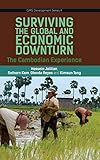Surviving the Global Financial and Economic Downturn : The Cambodia Experience / Hossein Jalilian, Sothorn Kem, Glenda Reyes.
Material type: TextPublisher: Singapore : ISEAS Publishing, [2014]Copyright date: 2014Description: 1 online resource (268 p.)Content type:
TextPublisher: Singapore : ISEAS Publishing, [2014]Copyright date: 2014Description: 1 online resource (268 p.)Content type: - 9789814459662
- 9789814459679
- 331.25
- HC442 .J34 2014
- HD6957
- online - DeGruyter
| Item type | Current library | Call number | URL | Status | Notes | Barcode | |
|---|---|---|---|---|---|---|---|
 eBook
eBook
|
Biblioteca "Angelicum" Pont. Univ. S.Tommaso d'Aquino Nuvola online | online - DeGruyter (Browse shelf(Opens below)) | Online access | Not for loan (Accesso limitato) | Accesso per gli utenti autorizzati / Access for authorized users | (dgr)9789814459679 |
Frontmatter -- CONTENTS -- List of Figures -- List of Tables -- List of Acronyms and Abbreviations -- Foreword -- Acknowledgements -- List of Authors -- 1. Triple Crises in Post-conflict Milieu -- 2. Losing Steam -- 3. The Human Face of the Crisis -- 4. The Human Face of the Crisis -- 5. The Food and Economic Crises -- 6. Road to Recovery -- Index
restricted access online access with authorization star
http://purl.org/coar/access_right/c_16ec
The global financial and economic shock of 2007–09 is the third major economic crisis to have buffeted Cambodia in its post-conflict period, coming in the wake of the food crisis of 2007–08 and just a decade after the Asian financial crisis of 1997–98 (the “triple crises”). Cambodia’s post-conflict history can be divided into two periods: 1991–98, referred to as the early phase of transition during which the first of the triple crises, the Asian financial crisis, occurred; and 1998 to the present, the late phase of transition during which the food and economic shocks transpired. A stocktake of the developments in Cambodia’s post-conflict history suggests that the country has come a long way in reinstituting the foundations of a capitalist economic and procedural democracy but has yet to make significant headway in economic sophistication and substantive democracy. The triple crises were different, yet had similar characteristics. They were all exogenously-driven shocks with their own specific causes but their effects were shaped by the country’s situation at the time. In terms of magnitude of impact, the global financial and economic downturn was the worst of the three crises. That it caused the first ever growth contraction in the post-conflict period was sufficient rationale for the series of studies that substantiate this book. Like the two shocks that preceded it however, the way it impacted on Cambodia cannot be understood in isolation from the overall post-conflict milieu. The thesis here is not that endogenous factors caused the crisis. It is simply that endogenous factors shaped the impact of the crisis and a historical, as opposed to a static, analysis better illuminates the nature of the impact. This book is an in-depth comprehensive examination of the impact of the global financial and economic crisis on Cambodia. It probes into the effects of the shock at macro, sectoral and micro levels using qualitative and quantitative techniques.
Mode of access: Internet via World Wide Web.
In English.
Description based on online resource; title from PDF title page (publisher's Web site, viewed 26. Aug 2024)


